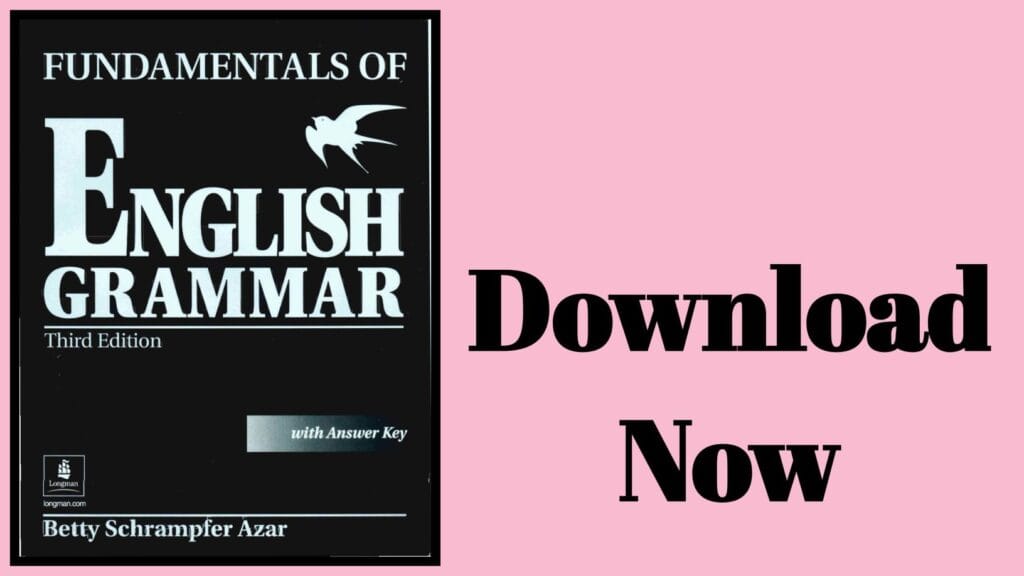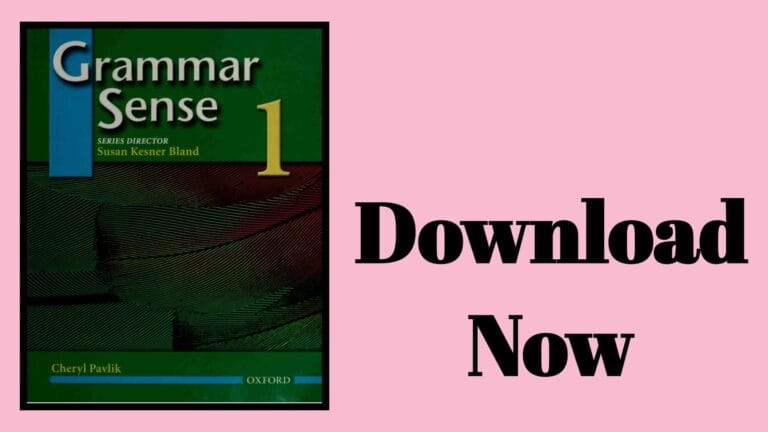
Book Description
“Fundamentals of English Grammar” is a wonderful book on English grammar that is designed for all learners of any levels of grammar; that is, beginner, intermediate and advanced learners can use this book in order to gain, strengthen and refresh their knowledge of grammars of the English language through its wonderfully and beautifully crafted lessons.
As the name suggests, the book touches on the core topics of English grammar that each and every learner must focus on when they starts the grammar learning journey. A thorough reading of the book can bring a lot of benefits for the readers in terms of grammars and rules of the English language.
Why Use This Book for Grammar
Before you download the book, make sure to browse through its contents and look at them carefully and ensure that you read a few passages of the book online on this post which can help you make a final decision about it. The book under discussion should be very beneficial for the students for the following reasons:
- Unique Style of Teaching: How much you can extract from any book depends on the teaching style of the book author. Therefore, The author of the book concerned has made sure to employ his unique method of grammar teaching to students which is easy to understand.
- Relevant Topics: In a book designed for students, the writer has to stick to the relevant topics that are essential from learners’ perspective and that can prove to be useful and enjoyable. You can fully realize this part of the book when you start reading its contents.
- Supportive Examples: Any grammar book contains a lot of grammars and rules which is considered to be a theory book. A theory book without proper supportive examples can be futile and useless. Therefore, the author has made an onerous effort and kept in mind the fact in this book.
Table of Book Contents
Preface to the Third Edition
Acknowledgments
Chapter 1: Present Time
The simple present and the present progressive
Forms of the simple present and the present progressive
Frequency adverbs
Final -s
Spelling of final -s/-es
Non-action verbs
Present verbs: short answers to yes/no questions
Chapter 2: Past Time
Expressing past time: the simple past
Forms of the simple past: regular verbs
Forms of the simple past: be
Regular verbs: pronunciation of -ed endings
Spelling of -ing and -ed forms
The principal parts of a verb
Irregular verbs: a reference list
The simple past and the past progressive
Forms of the past progressive
Expressing past time: using time clauses
Expressing past habit: used to
Chapter 3: Future Time
Expressing future time: be going to and will
Forms with be going to
Forms with will
Sureness about the future
Be going to vs. will
Expressing the future in time clauses and if-clauses
Using the present progressive to express future time
Using the simple present to express future time
Immediate future: using be about to
Parallel verbs
Chapter 4: The Present Perfect and the Past Perfect
Past participle
Forms of the present perfect
Meanings of the present perfect
Simple past vs. present perfect
Using since and for
Present perfect progressive
Present perfect progressive vs. present perfect
Using already, yet, still, and anymore
Past perfect
Chapter 5: Asking Questions
Yes/no questions and short answers
Yes/no questions and information questions
Where, why, when, and what time
Questions with who, who(m), and what
Spoken and written contractions with question words
Using what + a form of do
Using what kind of
Using which
Using whose
Using how
Using how often
Using how far
Length of time: it + take and how long
More questions with how
Using how about and what about
Tag questions
Chapter 6: Nouns and Pronouns
Pronunciation of final -s/-es
Plural forms of nouns
Subjects, verbs, and objects
Objects of prepositions
Prepositions of time
Word order: place and time
Subject-verb agreement
Using adjectives to describe nouns
Using nouns as adjectives
Personal pronouns: subjects and objects
Possessive nouns
Possessive pronouns and adjectives
Reflexive pronouns
Singular forms of other: another vs. the other
Plural forms of other: other(s) vs. the other(s)
Summary of forms of other
Chapter 7: Modal Auxiliaries
The form of modal auxiliaries
Expressing ability: can and could
Expressing possibility: may and might
Expressing permission: may and can
Using could to express possibility
Polite questions: may I, could I, can I
Polite questions: would you, could you, will you, can you
Expressing advice: should and ought to
Expressing advice: had better
Expressing necessity: have to, have got to, must
Expressing lack of necessity: do not have to
Expressing prohibition: must not
Making logical conclusions: must
Giving instructions: imperative sentences
Making suggestions: let’s and why don’t
Stating preferences: prefer, like … better, would rather
Chapter 8: Connecting Ideas
Connecting ideas with and
Connecting ideas with but and or
Using auxiliary verbs after but and and
Using and + too, so, either, neither
Connecting ideas with because
Connecting ideas with even though/although
Chapter 9: Comparisons
Making comparisons with as … as
Comparative and superlative
Comparative and superlative forms of adjectives and adverbs
Completing a comparative
Modifying comparatives
Comparisons with less … than and not as … as
Unclear comparisons
Using more with nouns
Repeating a comparative
Using double comparatives
Using superlatives
Using the same, similar, different, like, alike
Chapter 10: The Passive
Active sentences and passive sentences
Form of the passive
Transitive and intransitive verbs
Using the by-phrase
The passive forms of the present and past progressive
Passive modal auxiliaries
Using past participles as adjectives (stative passive)
Participial adjectives: -ed vs. -ing
Get + adjective; get + past participle
Using be used/accustomed to and get used/accustomed to
Used to vs. be used to
Using be supposed to
Chapter 11: Count/Noncount Nouns and Articles
A vs. an
Count and noncount nouns
Noncount nouns
More noncount nouns
Using several, a lot of, many/much, and a few/a little
Nouns that can be count or noncount
Using units of measure with noncount nouns
Guidelines for article usage
Using the or Ø with names
Capitalization
Chapter 12: Adjective Clauses
Adjective clauses: introduction
Using who and whom in adjective clauses
Using who, who(m), and that in adjective clauses
Using which and that in adjective clauses
Singular and plural verbs in adjective clauses
Using prepositions in adjective clauses
Using whose in adjective clauses
Chapter 13: Gerunds and Infinitives
Verb + gerund
Go + -ing
Verb + infinitive
Verb + gerund or infinitive
Preposition + gerund
Using by and with to express how something is done
Using gerunds as subjects; using it + infinitive
It + infinitive: using for (someone)
Expressing purpose with in order to and for
Using infinitives with too and enough
Chapter 14: Noun Clauses
Noun clauses: introduction
Noun clauses that begin with a question word
Noun clauses with who, what, whose + be
Noun clauses that begin with if or whether
Noun clauses that begin with that
Other uses of that-clauses
Substituting so for a that-clause in conversational responses
Quoted speech
Quoted speech vs. reported speech
Verb forms in reported speech
Common reporting verbs: tell, ask, answer/reply
Appendix 1: Phrasal Verbs
Phrasal verbs: introduction
Phrasal verbs: intransitive
Three-word phrasal verbs
Phrasal verbs: a reference list
Appendix 2: Preposition Combinations
Preposition combinations: introduction
Preposition combinations: a reference list
Answer Key
Index



Thanks for the wonderful job you and your team are doing for mankind